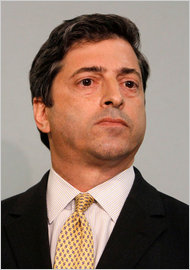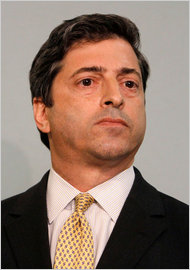 Jacquelyn Martin/Associated PressRobert S. Khuzami, the Securities and Exchange Commission‘s director of enforcement.
Jacquelyn Martin/Associated PressRobert S. Khuzami, the Securities and Exchange Commission‘s director of enforcement.
The Securities and Exchange Commission has brought civil actions against six former top executives at the mortgage giants Fannie Mae and Freddie Mac, saying that the executives did not adequately disclose their firms’ exposure to risky mortgages in the run-up to the financial crisis.
The case is one of the most significant federal actions taken against top executives at the center of the housing bust and ensuing financial crisis. Fannie Mae and Freddie Mac have been lightning rods in Washington as symbols of the excessive risk-taking that pushed the country into an economic downturn.
The agency filed complaints on Friday in the United States District Court in Manhattan against three former executives at Fannie Mae – its chief executive, Daniel H. Mudd; chief risk officer, Enrico Dallavecchia; and executive vice president, Thomas A. Lund.
Freddie Mac’s former chief executive, Richard F. Syron; Patricia Cook, its chief business officer; and its executive vice president, Donald J. Bisenius, were also named in a separate complaint.
“Fannie Mae and Freddie Mac executives told the world that their subprime exposure was substantially smaller than it really was,” Robert Khuzami, the head of enforcement for the S.E.C., said in a statement. “These material misstatements occurred during a time of acute investor interest in financial institutions’ exposure to subprime loans, and misled the market about the amount of risk on the company’s books. All individuals, regardless of their rank or position, will be held accountable for perpetuating half-truths or misrepresentations about matters materially important to the interest of our country’s investors.”
As part of its announcement, the S.E.C. said that Fannie Mae and Freddie Mac agreed to settle with regulators and cooperate with its investigation of former executives. The Justice Department has also investigated the two mortgage giants, but no charges have been brought.
The S.E.C.’s cases against the executives will rely heavily on whether the two mortgage companies underreported or misled investors about their ownership of subprime loans and mortgages that required few documents from borrowers in the years leading up to and including the housing bust.
The complaint alleges, for instance, that Fannie Mae executives described subprime loans as those made to individuals “with weaker credit histories” while only reporting one-tenth of the loans that met that criteria in 2007. The S.E.C. complaint contends that Freddie Mac executives falsely proclaimed that certain businesses had virtually no exposure to ultra-risky loans.
But Mr. Mudd, who was C.E.O. of Fannie Mae from 2005 until the government took control of the company in 2008, said that there had been no deception.
“The government reviewed and approved the company’s disclosures during my tenure, and through the present,” he said in a statement. “Now it appears that the government has negotiated a deal to hold the government, and government-appointed executives who have signed the same disclosures since my departure, blameless– so that it can sue individuals it fired years ago.”
“This is a lawsuit that should never have been brought in the United States of America,” he said.
In its statement, lawyers for Mr. Syron called the S.E.C.’s case “fatally flawed” and “without merit.”
“Simply stated, there was no shortage of meaningful disclosures, all of which permitted the reader to asses the degree of risk in Freddie Mac’s guaranteed portfolio,” Thomas C. Green and Mark D. Hopson, partners at Sidley Austin, said in the statement.
Michael M. Levy, a lawyer for Mr. Lund, said his client did not mislead anyone. “During a period of unprecedented disruption in the housing market, nobody worked more diligently or honestly to serve the best interests of both investors and homeowners,” Mr. Levy said. “When the truth comes out at trial, it will be abundantly clear that Mr. Lund — who did not sell a single share of Fannie Mae stock during this entire period — acted appropriately at all times.”
Still, the S.E.C., which has been maligned for failing to detect the crisis or punish its culprits, took pains Friday to underscore its renewed efforts to crack down on wrongdoing at the highest levels of Wall Street and corporate America.
“They are just the latest in a long line of financial related cases,” Mr. Khuzami said, noting that the agency has now filed 38 separate actions stemming from the crisis.
The case against the mortgage giants mirrors an earlier action against one of the nation’s biggest lenders to risky, or subprime, borrowers. Angelo Mozilo, the former chief executive and founder of Countrywide Financial, agreed to pay $22.5 million to settle federal charges along the same lines. The settlement was the largest ever levied against a senior executive of a public company, though Mr. Mozilo, who also agreed to forfeit $45 million in gains, neither admitted nor denied wrongdoing.
The S.E.C. has spent roughly two years interviewing former and current employees of Fannie Mae and Freddie Mac.
Earlier this year, the agency sent Wells notices, which warn of potential enforcement actions, to a number of top executives at the two firms. At the time, Mr. Syron, Mr. Mudd, Mr. Bisenius and Mr. Piszel all challenged those potential accusations.
Mr. Mudd and Mr. Syron are the two most prominent subjects of the complaint.
Since August 2009, Mr. Mudd has been chief executive of Fortress Investment Group, the large publicly traded private equity and hedge fund company.
In a statement, Gordon E. Runté of Fortress said: This morning, the S.E.C. filed a civil complaint against Dan Mudd, related to matters associated with his previous employment at Fannie Mae. The complaint does not relate to Fortress, and this matter has not impacted our company or our business operations. We are undertaking a thorough review of the matters addressed in the complaint.”
Mr. Syron is a former president of the American Stock Exchange and currently an adjunct professor and trustee at Boston College.
A lawyer for Mr. Dallavecchia did not immediately respond to a request for comment.
Lawyers for Ms. Cook and Mr. Bisenius could not immediately be reached for comment.
Fannie Mae and Freddie Mac were created by Congress to facilitate homeownership. Though they do not loan money to borrowers themselves, they buy mortgages from lenders and resell them in packages to investors, which allows banks and others to issue more loans. By 2005, the two companies began an aggressive push to expand their mandate to include less-fortunate borrowers who were typically excluded, an effort encouraged by lawmakers and lenders. The companies were also looking to reclaim business from Wall Street, which was thriving in the world of subprime mortgages.
But by the middle of 2008, as the housing market was sinking, exposure to subprime and other weak borrowers threatened the two companies. The Bush administration stepped in to rescue the two mortgage giants in September 2008, taking control of them in the process. Since then, the government has loaned the Fannie Mae and Freddie Mac more than $100 billion.
That the settlement with the two companies did not include a fine reflects their financially precarious situation. The Obama administration announced plans earlier this year to wind down the two companies.
S.E.C. v Mudd, Dallavecchia and Lund
S.E.C. v Syron, Cook and Bisenius
Article source: http://dealbook.nytimes.com/2011/12/16/s-e-c-sues-6-former-top-fannie-and-freddie-executives/?partner=rss&emc=rss
